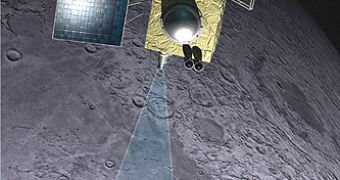Scheduled to launch on October 22nd this year, Chandrayaan-1 will be the first scientific mission to the Moon for the Indian Space Research Organisation's (ISRO). The European Space Agency (ESA) will be providing three scientific instruments, which will be placed onboard the lunar orbiter. Chandra represents the name of a lunar deity in Hindi, while the name Chandrayaan means "Moon vehicle" or "Moon craft". You might think that by now we should know many things about the bodies orbiting the Earth, but the strangest aspect of the cosmic objects present in the universe is that the more you find out about them, the less you seem to know.
Equipped with X-ray, optical and infrared observation instruments, Chandrayaan-1 will be one of the lunar orbiters with the closest orbit in relation to the surface of the Moon, meaning it will have a circular eccentricity, or orbit, that would take it only 100 kilometers above the lunar surface.
This will enable it to make high resolution pictures of the surface. Most of the images of the surface of the Moon have resolutions of about 30 to 100 meters; however, Chandrayaan will produce images with details up to 5-10 meters.
This will be the second lunar orbiter in which the European Space Agency gets involved, after the success experienced by their SMART-1 orbiter, which was launched in 2003 and completed its objective about three years later. The highly experienced crew of the ESA will assist the Indian Space Research Organization in handling data and flight dynamics, after the launch of the spacecraft.
On top of the instruments onboard the orbiter, ISRO's Chandrayaan spacecraft will also be equipped with a cargo consisting of the Moon Impact Probe, or MIP for short, a 29-kilogram satellite that will be deployed to the surface of the Moon during the first stages of the probing mission.
Some of the most important instruments carried by Chandrayaan-1 lunar module will consist of the X-ray spectrometer, Sub Kev Atom reflecting Analyzer and the Near Infrared Spectrometer. The X-ray spectrometer will have the task of mapping the whole surface of the Moon with the help of low energy X-ray. It was originally used in the first European lunar orbiter along with the Near Infrared Spectrometer; both instruments have been upgraded and rebuilt specially for the Chandrayaan-1 orbiter.
The third instrument, SARA of the Sub Kev Atom reflection Analyzer, will study the interactions between electrically charged particles coming from the Sun, in the form of solar wind, and the surface of the Moon. Unlike the surface of the Earth that is protected by a dense atmosphere, the Moon's extremely thin atmosphere permits particles to travel all the way to the surface.
ESA's next scheduled mission to a solar system body will most likely be the 2013 launch of BepiColombo spacecraft, which will carry a 1-year mission to the planet Mercury starting 2019; thus, the Indian Chandrayaan-1 lunar orbiter will further help the European Space Agency to perform a complete analysis of the Moon, in order to compare it with the smallest planet in the solar system.

 14 DAY TRIAL //
14 DAY TRIAL //